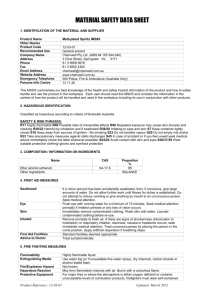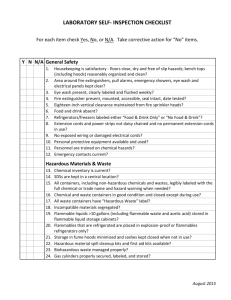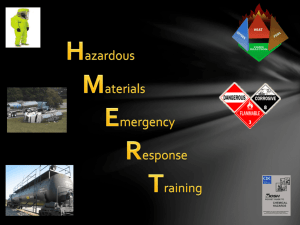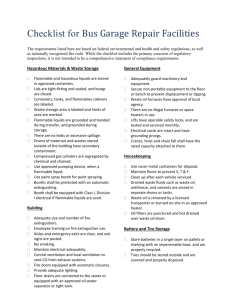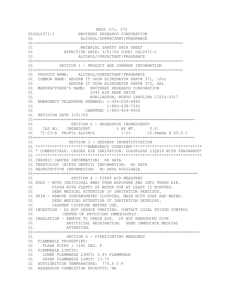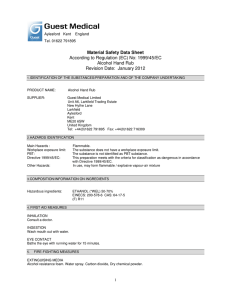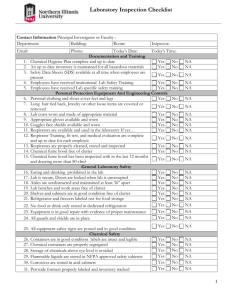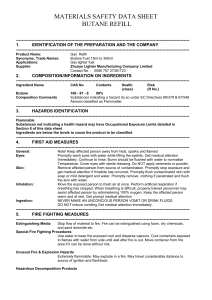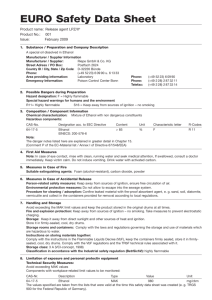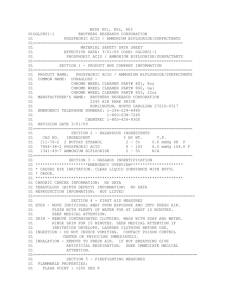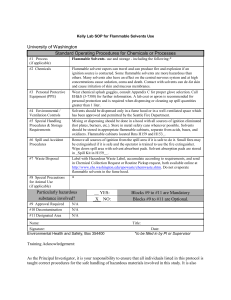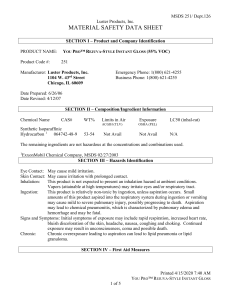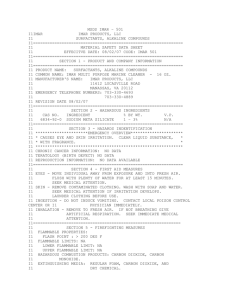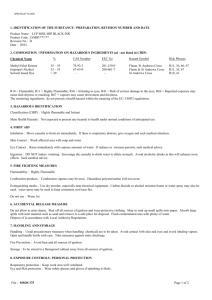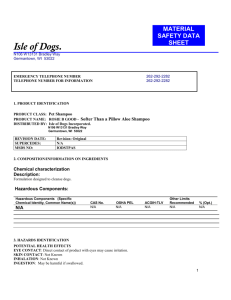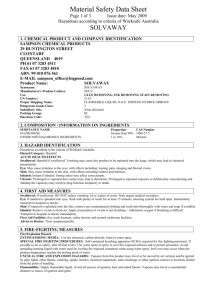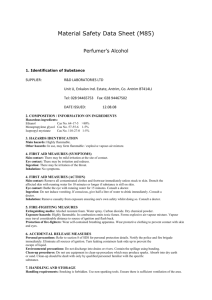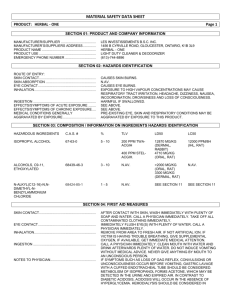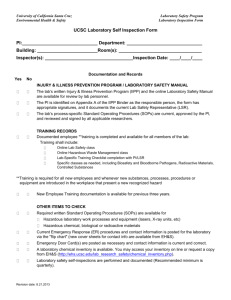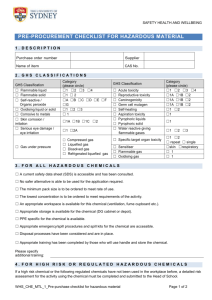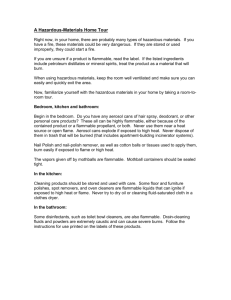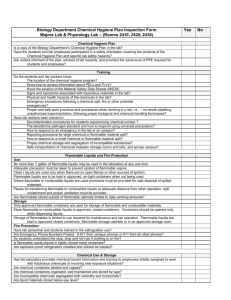MATERIAL SAFETY DATA SHEET IDENTIFICATION COMMERCIAL
advertisement
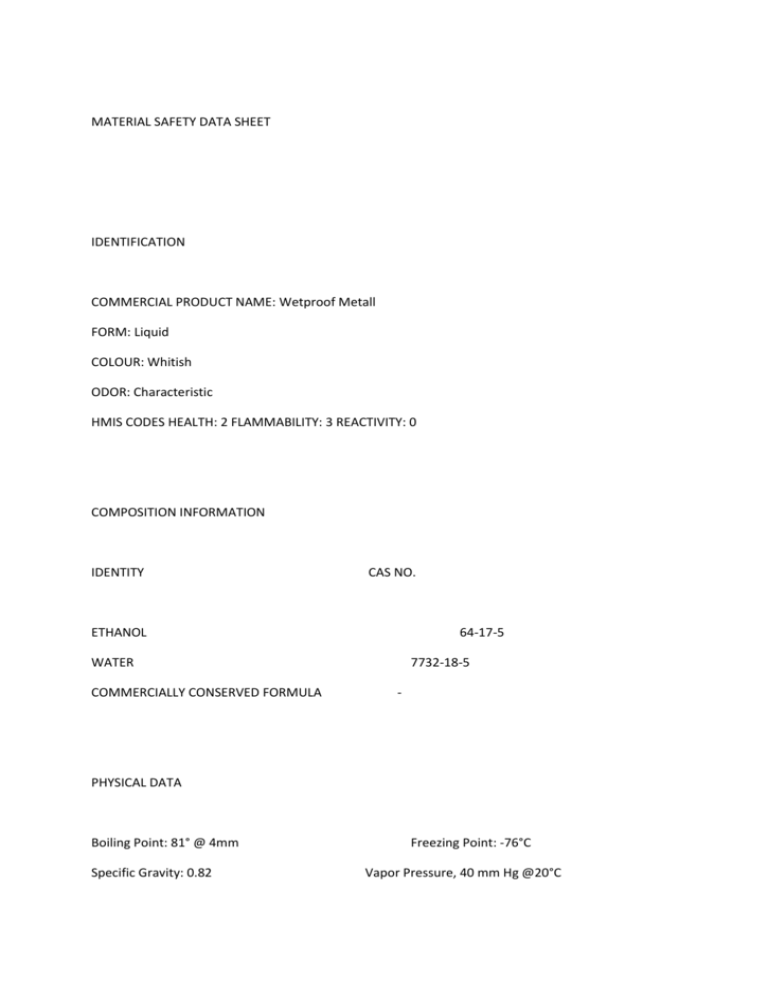
MATERIAL SAFETY DATA SHEET IDENTIFICATION COMMERCIAL PRODUCT NAME: Wetproof Metall FORM: Liquid COLOUR: Whitish ODOR: Characteristic HMIS CODES HEALTH: 2 FLAMMABILITY: 3 REACTIVITY: 0 COMPOSITION INFORMATION IDENTITY CAS NO. ETHANOL 64-17-5 WATER COMMERCIALLY CONSERVED FORMULA 7732-18-5 - PHYSICAL DATA Boiling Point: 81° @ 4mm Specific Gravity: 0.82 Freezing Point: -76°C Vapor Pressure, 40 mm Hg @20°C Vapor Density (air=1): >1.52 Solubility in water: miscible % volatiles: %100 Evaporation rate: 2.8 HAZARDS IDENTIFICATION HIGHLY FLAMMABLE (R16 S43) FLASH POINT: (R11) 17.6°C AUTOIGNITION TEMPERATURE: 375°C EXPLOSION LIMITS:LOWER: 3.4%v/v UPPER: 17%v/v PROTECTION AGAINST FIRE & EXPLOSION: Combustible vapours heavier than air. May form explosive mixtures with air. Take measures to prevent electrostatic charges. FIRST AID MEASURES SKIN CONTACT (S24) Irritating to skin. Remove affected person from source of contamination. Wash contaminated skin promptly with soap or mild detergent and water. Remove clothing promptly, if soaked through, and wash as above. EYE CONTACT (S25) Immediately flush eyes with plenty of water for at least 15 minutes, occasionally lifting the upper and lower eyelids. Get medical aid. Gently lift eyelids and flush continuously with water. INGESTION Do NOT induce vomiting unless directed to do so by medical personnel. Never give anything by mouth to an unconscious INHALATION Remove from exposure and move to fresh air immediately. If not breathing, give artificial respiration. If breathing is difficult, give oxygen. Get medical aid. Do NOT use mouth-to-mouth resuscitation. If breathing is difficult, give oxygen. Get medical aid. Do NOT use mouth-to-mouth resuscitation. FIRE FIGHTING MEASURES EXTINGUISHING MEDIA Use extinguishing media appropriate for surrounding fire. Water, dry chemicals, (BC or ABC powder), CO2, sand, dolomite, etc. Foam. DO NOT extinguish fire unless flow can be stopped first. SPECIAL FIRE FIGHTING PROCEDURES Keep upwind. Shut down all possible sources of ignition. Water may be ineffective but use to keep fire-exposed containers cool. Keep run-off water out of sewers and water sources. Dike for water control. Avoid water in straight hose stream; will scatter and spread fire. Use spray or fog nozzles. Cool containers exposed to flames with water from the side until well after the fire is out. Move container from fire area if it can be done without risk. If risk of water pollution occurs, notify appropriate authorities. UNUSUAL FIRE & EXPLOSION HAZARDS Makes explosive mixtures with air. Extremely flammable. May explode in a fire. May travel considerable distance to source of ignition and flash back. HAZARDOUS DECOMPOSITION PRODUCTS Gases of: Carbon monoxide (CO) Carbon dioxide (CO2) ACCIDENTAL RELEASE MEASURES SPILL CLEANUP METHODS In Case of small spill, dilute with water and mop up, or absorb with an inert dry material and place in an appropriate waste disposal container. In case of large spill, flammable liqui keep away from heat. Keep away from sources of ignition. Stop leak if without risk. Absorb with DRY earth,sand or other non-combustible material. Do not touch spilled material. Prevent entry into sewers, basements or confined, areas; dike if needed. HANDLING AND STORAGE USAGE PRECAUTIONS Wash thoroughly after handling. Use only in a well-ventilated area. Ground and bond containers when transferring material. Use spark-proof tools and explosion proof equipment. Avoid contact with eyes, skin, and clothing. Empty containers retain product residue, (liquid and/or vapor), and can be dangerous. Keep container tightly closed. Avoid contact with heat, sparks and flame. Avoid ingestion and inhalation. Do not pressurize, cut, weld, braze, solder, drill, grind, or expose empty containers to heat, sparks or open flames. STORAGE PRECAUTIONS Flammable/combustible. Keep away from oxidizers, heat and flames. May attack some plastics, rubber and coatings. Keep in cool, dry, ventilated storage and closed containers. Ground the container and transfer equipment to eliminate static electric sparks. STORAGE CRITERIA Flammable liquid storage. EXPOSURE CONTROLS AND PERSONAL PROTECTION VENTILATION Store in a well-ventilated area. RESPIRATORS No specific recommendation made, but respiratory protection must be used if the general level exceeds the Occupational Exposure Level (OEL). PROTECTIVE GLOVES Use protective gloves made of butyl rubber. EYE PROTECTION Wear approved chemical safety goggles where eye exposure is reasonably probable. Contact lenses should not be worn when working with this chemical! OTHER PROTECTION Use engineering controls to reduce air contamination to permissible exposure level. Provide eyewash station and safety shower. Wear appropriate clothing to prevent repeated or prolonged skin contact. STABILITY AND REACTIVITY Chemical Stability: Stable under normal temperatures and pressures. Conditions to Avoid: Incompatible materials, ignition sources, excess heat, oxidizers. Incompatibilities with Other Materials: Strong oxidizing agents, acids, alkali metals, ammonia, hydrazine, peroxides, sodium, acid anhydrides, calcium hypochlorite, chromyl chloride, nitrosyl perchlorate, bromine pentafluoride, perchloric acid, silver nitrate, mercuric nitrate, potassium-tert-butoxide, magnesium perchlorate, acid chlorides, platinum, uranium hexafluoride, silver oxide, iodine heptafluoride, acetyl bromide, disulfuryl difluoride, tetrachlorosilane + water, acetyl chloride, permanganic acid, ruthenium (VIII) oxide, uranyl perchlorate, potassium dioxide. Hazardous Decomposition Products: Carbon monoxide, irritating and toxic fumes and gases, carbon dioxide. Hazardous Polymerization: Will not occur. TOXICOLOGICAL INFORMATION TOXIC DOSE 1-LD50: 7080.00 mg/kg (oral rat) HEALTH WARNINGS Vapour is harmful on prolonged exposure or in high concentration.When in a concentration of more than 50%, Nasiol-M causes local mucosal lesions through dehydration and albumin precipitation. Absorption, which occurs swiftly from the gastrointestinal tract, causes euphoria, with subsequent dizziness, inebriation, paralysis, diminished reflex, excitability, cyanosis, narcosis and respiratory paralysis. Dangerous intolerance reactions and increased absorption occur through the simultaneous action of disulfiram, trichloroethylene, tetra-chloromethane, nitrobenzene, carbon disulfide, aniline, lime-nitrogen, arsenic, lead and mercury. CNS depressant. Repeated exposure may cause chronic eye irritation. Defatting, drying and cracking of skin. Mild dermatitis, allergic skin rash. Swallowing concentrated chemical may cause severe internal injury.MEDICAL SYMPTOMS: Rhinitis (inflammation of the nasal mucous membranes). Upper respiratory irritation. Skin irritation. Nausea, vomiting. MEDICAL CONSIDERATIONS Convulsive disorders, CNS problems. ECOLOGICAL INFORMATION Wetproof Metal is biodegradable and has not been shown to interfere in any way with waste water reatment plants. In high concentrations it harms fish and plankton. 9,000 mg/l kills fish in 24 hours; threshold for deleterious effects in small crustaceans (Daphnia): upwards of 7,800 mg/l. Toxic threshold concentration: Pseudomonas putida upwards of 6,500 mg/l, Scenedesmus quadricauda upwards of 5,000 mg/l, Microsystis aeruginosa upwards of 1,450 mg/l. Fish toxicity: LC50>10,000 mg/l. DISPOSAL CONSIDERATIONS Chemical waste generators must determine whether a discarded chemical is classified as a hazardous waste. US EPA guidelines for the classification determination are listed in 40 CFR Parts 261.3. Additionally, waste generators must consult state and local hazardous waste regulations to ensure complete and accurate classification. TRANSPORT INFORMATION LABEL FOR CONVEYANCE: Flammable Liquid 3 ROAD TRANSPORT: UN No: 1170 ADR CLASS No: 3 ADR ITEM No: 3(b) ADR LABEL No: 3 HAZCHEM CODE: 2YE CEFIC TEC(R) No: 32 RAIL TRANSPORT: RAIL TRANSPORT CLASS No: 3 RAILROAD PT: 3b SEA TRANSPORT: SEA TRANSPORT CLASS No: 3.2 IMDG Page No: 3074 SEA PACK GR: II AIR TRANSPORT: AIR TRANSPORT CLASS No: 3 AIR PACK GR: II Prepared by R&D dep. ISSUE DATE Wetproof Metal: 11/09/2013 The information contained in this document has been taken from reference materials and/or Wetproof, Inc. test data. Such information is offered solely for your consideration, investigation and verification. It is not suggested or guaranteed that the hazard precautions or procedures described are the only ones which exist. Wetproof Inc. makes no warranties, express or implied, with respect to the use of such information and assumes no responsibility therefore. Information on this safety data sheet is not intended to constitute a basis for product specifications.
